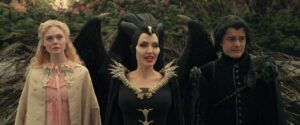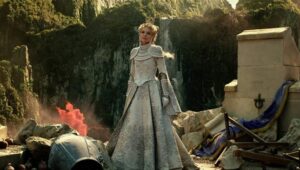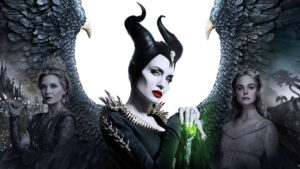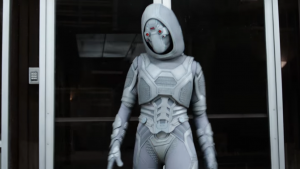The Marvel Cinematic Universe has (in)famously had a hard time establishing romantic relationships between its characters: even the few love stories that have helped to define the overarching story have sometimes gone through ups and downs, or simply collided headfirst with a brick wall and died (looking at you, Thor & Jane). And yet they keep trying to master the same old boy-meets-girl (or Norse-god-meets-girl, or boy-meets-alien, or computer-program-meets-girl) formula. That’s why, in celebration of Valentine’s Day, I’ve set myself a challenge: trying to find the ten most romantic, endearing, adorable couples in the MCU and ranking them.
Disclaimer: “ships” or non-canon pairings aren’t being considered on this list because that would be cheating – most MCU “ships” are at least ten times better than the majority of actual onscreen pairings. It’s simply not fair to compare.
10: Thor & Jane Foster.
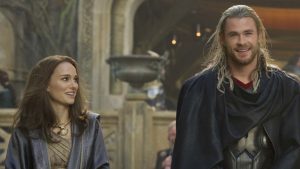
These two had something that looked like potential – I mean, if you squinted really hard. From the moment that Thor, the Norse God of Thunder and rightful heir to the throne of Asgard, crash-landed in the American Southwest, upsetting one of Jane Foster’s pseudo-scientific experiments, Marvel tried to convince audiences that a grand and glorious epic love-story for the ages was brewing – but all the magic (or “what your ancestors call magic”) words in the Marvel mythos couldn’t force Chris Hemsworth and Natalie Portman to look more than remotely disinterested in each other. And after Thor: The Dark World failed to turn up the heat, or really do anything at all, Portman had finally had enough: she quit the MCU, and Jane Foster was subsequently written out of the story. In Thor: Ragnarok, it was briefly mentioned that she broke up with the Thunder God offscreen – an uncomfortably awkward conclusion to what was supposed to be a cornerstone of Thor’s entire arc.
9: Stephen Strange & Christine Palmer.
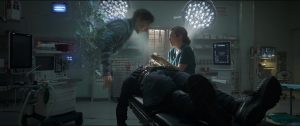
I’m actually tempted to move this couple ever so slightly further up the list, because while they’re not exactly memorable, they’re also probably not as bad and/or boring as you remembered. Dr. Stephen Strange, a snobbish, arrogant surgeon, wasn’t just the on-and-off boyfriend of Dr. Christine Palmer – he was also her work-partner, and it was mentioned (though never really elaborated on) that the two had even pioneered an important new surgical technique, making the couple basically equal. And after Strange’s run-in with karma, it was Palmer who tried to help him recover his strength and rebuild his life: their heated argument about Strange’s future is the most powerful scene in the Doctor Strange movie, and carries a lot of emotional weight. Unfortunately, Rachel McAdams’ character basically fades into the background after that, and apart from being privy to a battle on the astral plane and trying (unsuccessfully) to save the Ancient One’s life, she really has nothing more to do in the story. And she’s not returning for the sequel, so I guess that’s the end of that.
8: Peter Quill & Gamora.
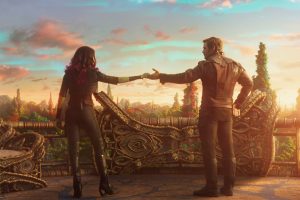
I don’t really like either Peter Quill (a.k.a. Star-Lord, an interstellar pirate armed with braggadocio, semi-Celestial powers that have proved to be entirely inconsequential outside of his own movies, and an impressive playlist of golden oldies), or Gamora (a.k.a. The Most Dangerous Woman In The Galaxy, who never actually lived up to that title before her untimely death at the hands of male screenwriters who didn’t know what else to do with her her own father, Thanos): nonetheless, I have to admit they had a spark of chemistry in both Guardians Of The Galaxy movies – and their interactions in Avengers: Infinity War, during which Gamora nearly convinced Quill to kill her (long story), are pretty emotional. There was something there! It wasn’t much, maybe, but it also wasn’t not there – much to the dismay of Thor & Peter Quill shippers everywhere. But in the end, Quill failed (because doesn’t he always?), Gamora got tossed off a cliff, and here we are with nothing left of their relationship but a sad trail of bubbles.
7: Natasha Romanoff & Bruce Banner.
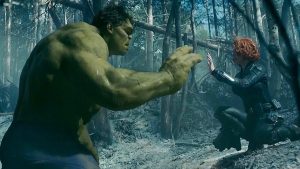
I like Avengers: Age Of Ultron. I know it’s unpopular to say this, but it’s honestly the best Avengers movie – not only because it references the events of Agents Of S.H.I.E.L.D., but also because it successfully balances almost all of the main characters while still being able to add a couple new ones to the mix. There’s a cohesive plot, the stakes are raised, and the Avengers get to interact with each other on a more personal, intimate level than ever before. And then there’s Natasha Romanoff’s random relationship with Bruce Banner – while it’s not a bad idea, and they make a cute couple, the basis for their coupling up is based on the problematic idea that they’re both “monsters”: Bruce, because he transforms into a giant green killing machine; Natasha, because she’s…infertile? The messaging is weird and kind of sexist, especially since it would have been way easier to make Natasha’s murderous past with the KGB the reason for her guilt and self-loathing. It’s a shame, because Natasha actually did have better interactions with Bruce than she ever had with her former love interest, Clint Barton, but for better or worse their story arc was completely abandoned in Avengers: Infinity War.
6: T’Challa & Nakia.
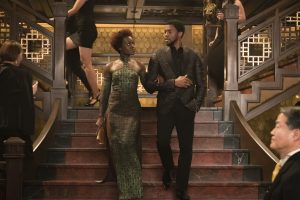
While there’s certainly an argument to be made that T’Challa, the catsuit-wearing guardian of the African nation of Wakanda, is slightly more low-key and subdued than many of his co-stars in Black Panther (let’s face it, he doesn’t have Okoye’s fiery energy, Killmonger’s smoldering charisma, or M’Baku’s macabre humor), there can be no denying that his relationship with Wakandan secret agent/humanitarian Nakia is super cute. The two are a power couple, with both characters having genuine hero moments – Nakia even briefly diverts the main focus of the film away from T’Challa, and considers becoming the Black Panther herself. By the end of the film, she’s also working around the world to help extend Wakandan aid to those in need. And when they’re onscreen together, they’re presented as a healthy, sturdy relationship that doesn’t have to rely on drama, troubling gender dynamics, or sarcastic banter to be interesting. They’re basically #CoupleGoals, and I love them.
5: Wanda Maximoff & The Vision.
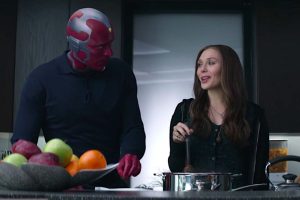
Ah, the tragic story of the computer program who became a man…once, for no apparent reason, and never did so again. The Vision, a sentient computer program outfitted with a cool new body (that, unfortunately for him, came along with the Mind Stone, one of the most coveted objects in the galaxy), didn’t really show any signs of attraction to the troubled witch, Wanda Maximoff, until Captain America: Civil War, but when their romance finally kicked into gear, and the two began to bond over spicy food, things got good – and then immediately got weird again, when Wanda blasted Vision through a floor, before suddenly…ending up on the run with him in Scotland? Where Vision was suddenly able to turn into a human man, but only did so once, for reasons that were never explained? Yeah, so there’s some serious gaps in what we actually know about their relationship, but at least it ended on a strong note, with Wanda having to brutally murder her lover in an attempt to destroy the Mind Stone before Thanos could get to it, only to watch Thanos use the Time Stone to reverse all her hard work, murder Vision again, and use the Stones to wipe out half the galaxy, including Wanda herself. If it’s any consolation, the upcoming WandaVision series on Disney+ will feature Wanda resurrecting her dead partner, only to have him presumably die once again when her entire reality inevitably comes crashing down around her. Cheerful, am I right?
4: Scott Lang & Hope Van Dyne.

Technically, there have been two canon MCU power couples that call themselves Ant-Man and The Wasp: Hope Van Dyne’s parents, Hank Pym and Janet Van Dyne, and then Hope herself and her partner, reformed burglar/single father/world’s best grandma, Scott Lang. But the latter couple has the edge on its predecessor, mostly because Janet doesn’t actually show up until the end of the second Ant-Man film, and most of her flashbacks with Hank were cut out of the movie anyway. Scott and Hope share the spotlight (and the title-card) in Ant-Man And The Wasp, which focuses almost entirely on their relationship – and their exchanges of playful, witty banter, coupled with their fidelity and focus on family, make them one of the most endearing couples in the MCU.
3: Steve Rogers & Peggy Carter.
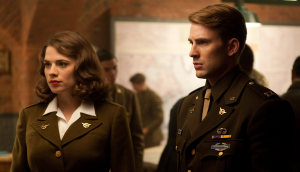
Specifically, their relationship in the first three Captain America films, before Avengers: Endgame happened. In the beginning, scrawny new recruit Steve Rogers and fast-talking, no-nonsense commanding officer Peggy Carter were actually quite a sweet pairing: they both had character arcs, and agency in their own stories. There was a quaint little 1940’s love story between them, but Peggy, by virtue of being in the military, wasn’t forced to play the damsel-in-distress or grieving-girlfriend-on-the-home-front roles: and in the post-war era, after Steve went down in the frigid Antarctic Ocean and was lost, she picked up her life and moved on, founding S.H.I.E.L.D. and starting a family. Her relationship with Steve after his resurrection from the ice was deeply emotional and interesting, and it was tragic when she passed away. But then to essentially reverse all the complexities of their post-The First Avenger relationship by having Steve go back in time and start all over with her, making her essentially a consolation prize for Steve after he failed to move on with his life, thus preventing her from moving on with hers? No, just no.
2: Tony Stark & Virginia “Pepper” Potts.

They’re the MCU’s original duo: how could they not come in near the top of the list? Tony was a sarcastic, cynical mess of a human being; a war-profiteer who didn’t care one iota about the countless people killed daily by his weapons of mass destruction; Pepper was the very opposite, a cool, collected woman with savvy business skills and a friendly disposition. It’s a trope, and a tired one at that. But their relationship evolved into so much more than that – Tony became Iron Man, and Pepper took over as CEO of Stark Industries. They constructed the Avengers Tower in New York City. In the five years after Avengers: Infinity War, they got married and had a daughter. In Avengers: Endgame, where they even got to fight in battle alongside each other, their decade-long relationship came to an end with Tony Stark’s tragic death. In that final moment, as the former “Merchant of Death” gave up his life to save the world, Pepper stayed beside him and her face was the last thing he ever saw. I’m not crying: you’re crying.
1: Leopold Fitz & Jemma Simmons.
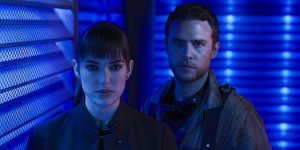
Yes, I cheated! Fitz and Simmons, or “Fitzsimmons” as they’re more commonly known among the fandom, are not technically members of the MCU: they come from the Marvel TV division, where they made their debut on Agents Of S.H.I.E.L.D. and have endured through six grueling, torturous seasons of hardship, personal loss, tragedy and pure, wholesome romance. While they started out as the team’s two bumbling, socially-awkward scientists, it didn’t take long before the universe’s vendetta against them resulted in them standing up for S.H.I.E.L.D., and for each other, in incredible ways. Their tense, frantic struggle to figure their way out of an airtight box at the bottom of the ocean (long story) was one of the highlights of Season 1, as it showed just how powerful the two are as a team – so of course they were then split up. Jemma became an undercover spy, got eaten by a space monolith, was transported to another planet and had to survive on her own, fell in love with an astronaut who turned into an evil alien god, was possessed by the Kree, was possibly hinted to be bisexual (come on, we all know she had a thing for Daisy), and even met and defeated the demonic personification of her self-doubt: Leo lost his ability to communicate for a long period of time and became delusional, was possibly hinted to be bisexual (come on, we all know he had a thing for Mac), became a dashing secret agent, met his evil HYDRA doppelganger, fell in love with HYDRA’s cyborg overlord, and then got stuck in two different time-periods at once, which resulted in him dying but still being alive and yet somehow a space pirate in both timelines…it’s a wacky and confusing series, but their love for each other, which persists even against all odds, has always been at the heart of the story, and I would be lying if I didn’t say they’re the most romantic couple in what used to technically be part of (or at least adjacent to) the MCU.
So what do you think of my top ten, and would you have chosen differently? Did I leave your favorite couple off my list? Share your thoughts in the comments below!
